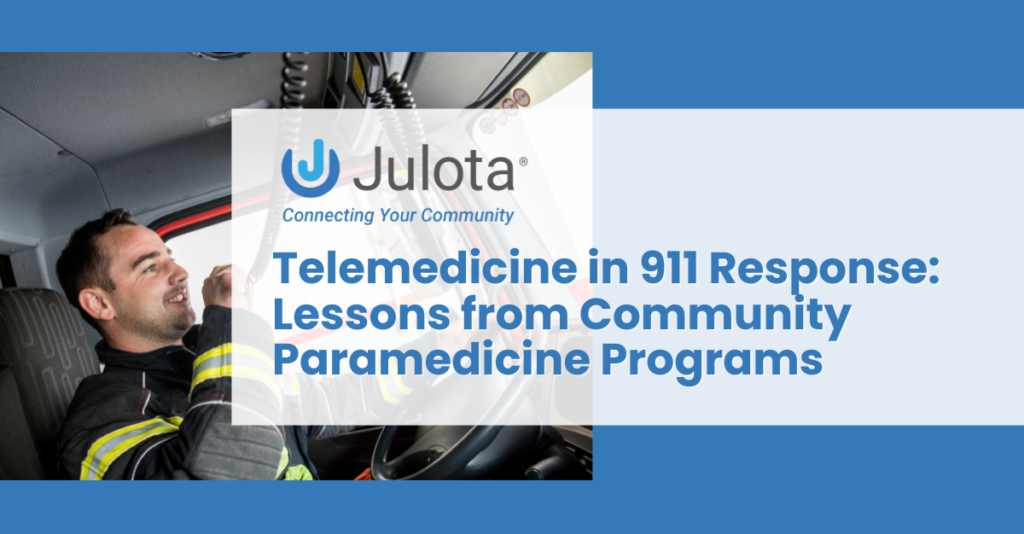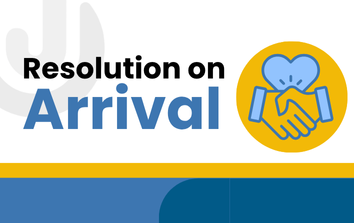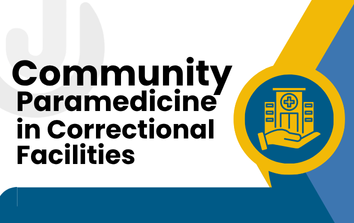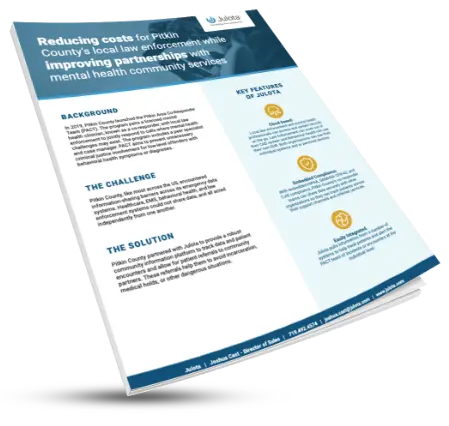The 911 response has undergone rapid changes in the digital age. In decades past, EMS personnel would sometimes have a radio to contact physicians in the hospital. Still, telemedicine in the 911 response means that live video can bring the patient directly in front of a specialist.
Using telemedicine, which is essentially live video communication between the patient and the attending physician, enables more advanced clinical diagnosis, facilitates easier transport and triage decisions, and allows patients to access a provider before determining whether to activate the emergency system. The video phone call has changed most things in the past twenty years – and the 911 response is no exception.

The Many Benefits of Telemedicine in 911 Response
Telemedicine would have seemed like the stuff of magic one hundred years ago, but today it’s a very real thing. In many areas, we’ve just seen the beginning of what telemedicine can do. In the years to come, you can expect to see much more telemedicine within the 911 response.
Not only that, but you’ll also likely see more telemedicine in dispatching, where trained personnel can assess a situation as they are sending help. This enables dispatchers to triage individuals and dispatch the appropriate resources more accurately.
How telemedicine works in 911 response:
- Telemedicine Brings the Physician to the Patient
- Telemedicine Allows for More Advanced Clinical Diagnosis in the Field
- Alternative Transport Destinations Can Benefit from Telemedicine
- Telemedicine can Help Paramedics Make Vital Treatment Decisions (Medical Control)
- Telemedicine Can Be an Alternative to 911 for Non-Emergency Needs
- Telemedicine Can Augment Push Button and Auto Alert Systems
Note: Telemedicine should be viewed as an augmentation to the traditional emergency response. Too many times, people dismiss an idea because they are asking it to do too much. Telemedicine is meant to aid 911 response, not replace it in any way.
911 Response and Community Paramedicine: Telemedicine Brings the Physician to the Patient
For many decades, we’ve been bringing the patient to the physician. But it wasn’t always that way. A long time ago, physicians would frequently make house calls. Technology has a way of making things go out of style and then bringing them back.
In an emergency, there are many benefits to bringing the physician into the field virtually. At times, paramedics encounter patients who present with confounding clinical dilemmas. For example, sometimes people who are seriously ill do not want to go to the hospital. In these cases, allowing the patient to chat directly with a doctor could be what changes their mind.
Furthermore, there are instances when a paramedic must make a complex clinical decision or perform a challenging procedure in the field. When these situations arise, telemedicine enables the EMS provider to contact a doctor and discuss the best course of action for the patient.
Now, let’s discuss how telemedicine can aid in diagnosis.
911 Response and Community Paramedicine: Telemedicine Allows for More Advanced Clinical Diagnosis in the Field
In EMS and emergency medicine in general, there is a saying: time is tissue. The idea is that the sooner a deadly condition is recognized, the sooner it can be treated, and the less body tissue that will be harmed. This could be the case with a stroke, where you have brain tissue on the line.
On the other hand, it could be a heart attack, where the myocardial tissue is in jeopardy. Further, it might be something like sepsis or even a head injury. Paramedics receive careful training on how to recognize, stabilize, and transport these patients to definitive care.
However, the problems start when things become lost in translation. A common situation would be a stroke. The paramedic is unsure if the patient meets the stroke criteria, and the physician can’t see the patient in person, so the alert isn’t called.
When you bring telemedicine into the mix, the paramedic and doctor can work together to assess the patient, ensuring that nothing is missed and that the patient receives the best possible care.
Now, let’s discuss alternative destination programs.
Alternative Transport Destinations Can Benefit from Telemedicine: 911 Response and Community Paramedicine
As you may have heard, 911 systems have been overwhelmed in recent times by high volumes of patients and limited staff resources. To cope, healthcare systems must get creative in how they coordinate emergency care.
The fact is that emergency resources should be reserved for people with genuine emergencies whenever possible. It’s a real tragedy when a stroke or heart attack is missed because the medical providers are simply too overwhelmed with patients.
An answer that is rising in popularity is alternative destination programs. The idea with these programs is that the EMS provider can transport someone to a non-emergency room if they meet certain criteria. However, there is danger here. What if someone with a genuine emergency is sent to an urgent care facility where they will not receive the necessary care?
That’s where telemedicine comes into play. When a paramedic responds to a 911 call, they will arrive on the scene and assess whether the patient is experiencing an emergency. At that time, a physician can be brought onto video chat and help the paramedic decide if non-ER transport is appropriate.
In this way, telemedicine in 911 response can help better allocate resources and reduce ambulance overuse and ER crowding.
911 Response and Community Paramedicine: Telemedicine can Help Paramedics Make Vital Treatment Decisions (Medical Control)
Paramedics call the ER almost daily, a practice known as “contacting medical control.” The medical control is the physician in charge of EMS treatment for that day. Most of the time, paramedics and physicians are only in contact via phone. This is good, but it leaves a lot on the table.
These days, telemedicine allows physicians and paramedics to contact each other via video chat, allowing the doctor to get a much better idea of what is going on (and to truly understand the situation). Video chat can be used in conjunction with other modern tools, such as screen sharing, for diagnostic tools like ECG monitors, SpO2, and ETCO2.
Essentially, the physician can see everything that the paramedic on scene can see, allowing them to provide the best medical direction.
Telemedicine Can Be an Alternative to 911 for Non-Emergency Needs
Yes, people have called 911 because they are unable to remove their socks. And they’ve called 911 because they’re having trouble reading their medicine bottle, or because they can’t seem to get their heat turned on.
We can scoff at these situations as “misuse of the 911 response,” or we can listen to what the data is telling us: people need more ways to get help than just dialing 911 and waiting for an ambulance.
Telemedicine provides an alternative option for individuals seeking assistance. Instead of going straight to 911, they can consult with a physician or nurse practitioner via video chat. In the best-case scenario, the provider helps the person solve their problem. However, if the provider can see that they are in true distress, they can activate the emergency response and send an ambulance to their home.
Telemedicine Can Augment Push Button and Auto Alert Systems: 911 Response and Community Paramedicine
Another area where telemedicine can excel is in conjunction with push-button or pull-cord emergency response activators. These are sometimes worn around a person’s neck or placed in key locations, such as the bathroom.
There are a couple of issues with the push-button response system. For one, some people won’t ever use them. Certain people just don’t feel comfortable with pushing a button and waiting to see what happens. These individuals are typically very self-reliant and would rather not bother anyone, even when they should (such as in a true emergency).
For the reluctant button-presser, telemedicine provides a way to contact help before activating the emergency response.
Now, on the far other side of the spectrum, you have people who believe that their emergency activation button should be pressed at the slightest inconvenience. These individuals may not have a strong social support system, or they may not be aware of the purpose of the emergency response.
For these individuals, telemedicine may be able to address some of their concerns without the need for an ambulance and rescue truck.
As you can see, telemedicine (when implemented right) can take almost any part of the 911 response and make it better.
Conclusion: The Best Ways You Can Use Telemedicine Within 911 Responses
If you’re considering incorporating telemedicine into your 911 response, start by taking a cue from community paramedic programs. Look at what worked, and what didn’t. Also, consider how telemedicine could be most helpful and begin with that.
Telemedicine can enhance the collaborative effort between paramedics and physicians, enabling them to make more informed treatment and transport decisions. Not only that, but telemedicine can sometimes be the difference in convincing a person to seek help for an emergency they would otherwise ignore (such as mild chest pain).
Just like anything, implementation is everything. Telemedicine must be carefully and safely integrated into your 911 system for optimal results.
Contact Julota to learn how their data collection platform can help you manage patients enrolled in telemedicine visits and enhance your 911 response.




